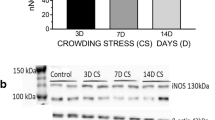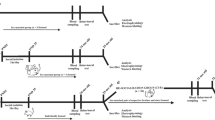Abstract
Chronic neuroendocrine stress usually leads to the elevation of the stress hormones and increased metabolic rate, which is frequently accompanied by oxidative damage to the CNS. In the present study we hypothesized that chronic psychosocial isolation (CPSI) of male Wistar rats, characterized by decreased serum corticosterone (CORT), unaltered catecholamines (CTs), and low blood glucose (GLU), may also promote oxidative imbalance in the CNS, by targeting antioxidant defense system. To test it, we have examined the relation between these input signals and protein expression/activity of antioxidant enzymes (AOEs): superoxide dismutases (SODs), catalase (CAT), glutathione peroxidase (GPx), and glutathione reductase (GLR) in the hippocampus (HIPPO) of CPSI animals. We found that CPSI did not affect SODs or CAT, but decreased activity of GPx and compromised GLR, an enzyme highly dependent on blood GLU for its substrate precursor. Further, we have tested whether the CPSI experience altered AOEs response to a novelty stress, and found that it attenuated peroxide-metabolizing enzymes, CAT and GPx, and decreased GLR activity, even though blood GLU was restored. The altered ratios of hippocampal AOEs in CPSI animals, which were worsened under the combined stress conditions, may lead to the accumulation of peroxide products and oxidative imbalance. The mechanism by which CPSI generate oxidative imbalance in the HIPPO is most likely based on poor systemic energy conditions set by this stress. Such conditions may cause functional decline of CNS structures, such as HIPPO, and are likely to promote state linked to onset of many mood disorders.



Similar content being viewed by others
References
Adzic M, Djordjevic A, Demonacos C, Krstic-Demonacos M, Radojcic MB (2009a) The role of phosphorylated glucocorticoid receptor in mitochondrial functions and apoptotic signalling in brain tissue of stressed Wistar rats. Int J Biochem Cell Biol 41(11):2181–2188
Adzic M, Djordjevic J, Djordjevic A, Niciforovic A, Demonacos C, Radojcic MB, Krstic-Demonacos M (2009b) Acute or chronic stress induce cell compartment-specific phosphorylation of glucocorticoid receptor and alter its transcriptional activity in Wistar rat brain. J Endocrinol 202(1):87–97
Barnham KJ, Masters CL, Bush AI (2004) Neurodegenerative diseases and oxidative stress. Nat Rev Drug Discov 3(3):205–214
Bruce AJ, Boling W, Kindy MS, Peschon J, Kraemer PJ, Carpenter MK, Holtsberg FW, Mattson MP (1996) Altered neuronal and microglial responses to excitotoxic and ischemic brain injury in mice lacking TNF receptors. Nat Med 2(7):788–794
Claiborne A (1985) Handbook of methods for oxygene radical research. CRC Press, Boca Raton, FL, pp 283–284
De Kloet ER, Joels M, Holsboer F (2005) Stress and the brain: from adaptation to disease. Nat Rev Neurosci 6(6):463–475
Dean O, Bush AI, Berk M, Copolov DL, van den Buuse M (2009) Glutathione depletion in the brain disrupts short-term spatial memory in the Y-maze in rats and mice. Behav Brain Res 198(1):258–262
DeHaan JB, Iannello RC, Crack PJ, Hertzog P, Kola I (2003) Oxidative and free radical mechanisms in brain ageing. In: Sachdev PS (ed) The ageing brain. Psychology Press, UK, pp 187–203
Djordjevic A, Adzic M, Djordjevic J, Radojcic MB (2009) Chronic social isolation is related to both upregulation of plasticity genes and initiation of proapoptotic signaling in Wistar rat hippocampus. J Neural Transm 116:1579–1589
Eren I, Naziroglu M, Demirdas A, Celik O, Uguz AC, Altunbasak A, Ozmen I, Uz E (2007) Venlafaxine modulates depression-induced oxidative stress in brain and medulla of rat. Neurochem Res 32(3):497–505
Evans PH (1993) Free radicals in brain metabolism and pathology. Br Med Bull 49(3):577–587
Friedman JE, Yun JS, Patel YM, McGrane MM, Hanson RW (1993) Glucocorticoids regulate the induction of phosphoenolpyruvate carboxykinase (GTP) gene transcription during diabetes. J Biol Chem 268:12952–12957
Grillo CA, Piroli GG, Rosell DR, Hoskin EK, McEwen BS, Reagan LP (2003) Region specific increases in oxidative stress and superoxide dismutase in the hippocampus of diabetic rats subjected to stress. Neuroscience 121(1):133–140
Hovatta I, Tennant RS, Helton R, Marr RA, Singer O, Redwine JM, Ellison JA, Schadt EE, Verma IM, Lockhart DJ, Barlow C (2005) Glyoxalase 1 and glutathione reductase 1 regulate anxiety in mice. Nature 438(7068):662–666
Kaushik S, Kaur J (2003) Chronic cold exposure affects the antioxidant defense system in various rat tissues. Clin Chim Acta 333:69–77
Kvetnansky R, Mikulaj L (1970) Adrenal and urinary catecholamines in rat during adaptation to repeated immobilization stress. Endocrinology 87:1868–1874
Kvetnansky R, Pacak K, Fukuhara K, Viskupic E, Hiremagalur B, Nankova B, Goldstein DS, Sabban EL, Kopin IJ (1995) Sympathoadrenal system in stress. Interaction with the hypothalamic–pituitary–adrenocortical system. Ann N Y Acad Sci 771:131–158
Laemmli UK (1970) Cleavage of structural proteins during the assembly of the head of bacteriophage T4. Nature 227:680–685
Lindenau J, Noack H, Asayama K, Wolf G (1998) Enhanced cellular glutathione peroxidase immunoreactivity in activated astrocytes and in microglia during excitotoxin induced neurodegeneration. Glia 24(2):252–256
Liu J, Mori A (1999) Stress, aging, and brain oxidative damage. Neurochem Res 24(11):1479–1497
Magarinos AM, Somoza G, De Nicola AF (1987) Glucocorticoid negative feedback and glucocorticoid receptors after hippocampectomy in rats. Horm Metab Res 19:105–109
Maral J, Puget K, Michelson AM (1977) Comparative study of superoxide dismutase, catalase and glutathione peroxidase levels in erythrocytes of different animals. Biochem Biophys Res Commun 77:1525–1535
Markwell MA, Haas SM, Bieber LL, Tolbert NE (1978) A modification of the Lowry procedure to simplify protein determination in membrane and lipoprotein samples. Anal Biochem 87(1):206–210
Mattson MP, Liu D (2002) Energetics and oxidative stress in synaptic plasticity and neurodegenerative disorders. Neuromolecular Med 2(2):215–231
McIntosh LJ, Hong KE, Sapolsky RM (1998) Glucocorticoids may alter antioxidant enzyme capacity in the brain: baseline studies. Brain Res 791:209–214
McKay LI, Cidlowsky JA (2000) Corticosteroids. In: Bast Jr RC, Kufe DW, Pollock RE (eds) Cancer medicine, vol 54, 5th edn. Decker, Hamilton, pp 730–742
Ng F, Berk M, Dean O, Bush AI (2008) Oxidative stress in psychiatric disorders: evidence base and therapeutic implications. Int J Neuropsychopharmacol 11:851–876
Pal SN, Dandiya PC (1994) Glutathione as a cerebral substrate in depressive behavior. Pharmacol Biochem Behav 48:845–851
Peuler JD, Johnson GA (1977) Simultaneous single isotope radioenzymatic assay of plasma norepinephrine, epinephrine and dopamine. Life Sci 21:625–636
Power JHT, Blumbergs PC (2009) Cellular glutathione peroxidase in human brain: cellular distribution, and its potential role in the degradation of Lewy bodies in Parkinson’s disease and dementia with Lewy bodies. Acta Neuropathol 117:63–73
Reagan LP, Magarinos AM, McEwen BS (1999) Neurological changes induced by stress in streptozotocin diabetic rats. Ann N Y Acad Sci 893:126–137
Schad A, Fahimi HD, Völkl A, Baumgart E (2003) Expression of catalase mRNA and protein in adult rat brain: detection by nonradioactive in situ hybridization with signal amplification by catalyzed reporter deposition (ISH-CARD) and immunohistochemistry (IHC)/immunofluorescence (IF). J Histochem Cytochem 51(6):751–760
Smythies J, Galzigna L (1998) The oxidative metabolism of catecholamines in the brain: a review. Biochim Biophys Acta 1380(2):159–162
Sugiano N, Telleria CM, Gibori G (1998) Differential regulation of copper-zinc superoxide dismutase and manganese superoxide dismutase in the rat corpus luteum: induction of manganese superoxide dismutase messenger ribonucleic acid by inflammatory cytokines. Biol Reprod 59:208–215
Suh SW, Gum ET, Hamby AM, Chan PH, Swanson RA (2007) Hypoglycemic neuronal death is triggered by glucose reperfusion and activation of neuronal NADPH oxidase. J Clin Invest 117:910–918
Weisbrot-Lefkowitz M, Reuhl K, Perry B, Chan PH, Inouye M, Mirochnitchenko O (1998) Overexpression of human glutathione peroxidase protects transgenic mice against focal cerebral ischemia/reperfusion damage. Brain Res Mol Brain Res 53(1–2):333–338
Zafir A, Banu N (2007) Antioxidant potential of fluoxetine in comparison to Curcuma longa in restraint-stressed rats. Eur J Pharmacol 572(1):23–31
Zafir A, Banu N (2009) Induction of oxidative stress by restraint stress and corticosterone treatments in rats. Indian J Biochem Biophys 46(1):53–58
Acknowledgments
This work was supported by the Ministry of Science and Technological Development of the Republic of Serbia, Grant No. 143042B.
Author information
Authors and Affiliations
Corresponding author
Rights and permissions
About this article
Cite this article
Djordjevic, J., Djordjevic, A., Adzic, M. et al. Chronic Social Isolation Compromises the Activity of Both Glutathione Peroxidase and Catalase in Hippocampus of Male Wistar Rats. Cell Mol Neurobiol 30, 693–700 (2010). https://doi.org/10.1007/s10571-009-9493-0
Received:
Accepted:
Published:
Issue Date:
DOI: https://doi.org/10.1007/s10571-009-9493-0




